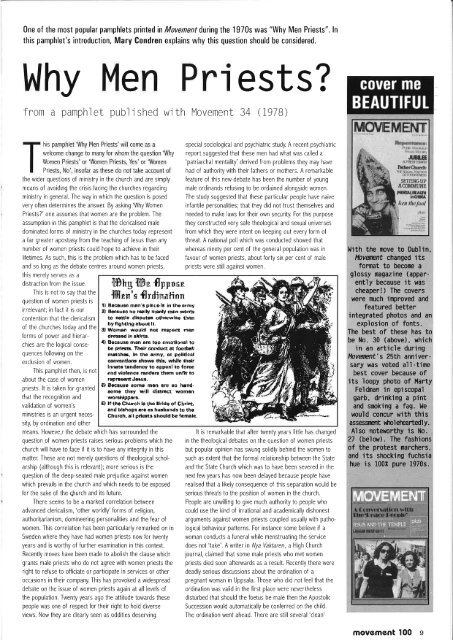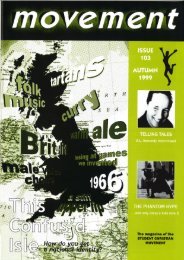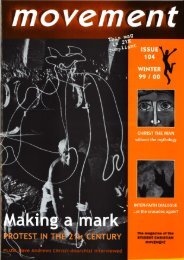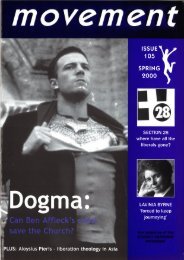Movement 100
Create successful ePaper yourself
Turn your PDF publications into a flip-book with our unique Google optimized e-Paper software.
One of the most popular pamphlets printed in <strong>Movement</strong> during the 1970s was "Why Men Priests". ln<br />
this pamphlet's introduction, Mary Condren explains why this question should be considered.<br />
Why Men Pr-i ests?<br />
from a pamphi et publ i shed wj th <strong>Movement</strong> 34 0978)<br />
his pamphlet 'Why Men Priests'will come as a<br />
f<br />
welcome change to many for whom the question 'Why<br />
Women Priests' or'Women Priests, Yes' or'Women<br />
I Priests, No', insofar as these do not take account of<br />
the wider questions of minisiry in the church and are simply<br />
means of avoiding the crisis facing the churches regardlng<br />
ministry in general. The way in which the question is posed<br />
very often determines the answer. By asking 'Why Women<br />
Priests?' one assumes that women are the problem, The<br />
assumption in this pamphlet is that the clericalised male<br />
dominated forms of ministry in the churches today represent<br />
a far greater apostasy from the teaching of Jesus than any<br />
number of women priests could hope to achieve in their<br />
lifetimes. As such, this is the problem which has to be faced<br />
and so long as the debate centres around women priests,<br />
this merely serves as a<br />
distraction from the issue.<br />
This is not to say that the<br />
question of women priests is<br />
irrelevant; in fact it is our<br />
contention that the clericalism<br />
of the churches today and the<br />
forms of power and hierarchies<br />
are the logical consequences<br />
following on the<br />
exclusion of women.<br />
This pamphlet then, is not<br />
about the case of women<br />
priests. lt is taken for granted<br />
that the recognition and<br />
validation of women's<br />
ministries is an urgent necessity,<br />
by ordination and other<br />
means. Howeve,r the debate which has surrounded the<br />
question of women priests raises serious problems which the<br />
church will have to face if it is to have any integrity in this<br />
matter. These are not merely questions of theological scholarship<br />
(although this is relevant); more serious is the<br />
question of the deep-seated male prejudice against women<br />
which prevails in the church and which needs to be exposed<br />
for the sake of the qhurch and its future.<br />
{HHhg {HBu, flppnsn<br />
flHrnns flrdimratinn<br />
1l Erceura man't plnr+ la in thE arfiy<br />
2l Ecc*ugr no rerlly murlv msfi $rafit8<br />
to r.lfite dbputia oth.rwl3e thqn<br />
by llght|ng €borrt lt.<br />
3l womEn *Truhl not re8fiftct man<br />
drc{aed ln rklrtr.<br />
4l Eocaus* mEn arc too efirofffid lc<br />
bd pdeit!. Th€lr Gonduat at tofftb.l<br />
m.tch6-, lh the rrmy. at FdlltlcEl<br />
lnnrta tendarcy to rpparl to forc€<br />
snd violcncc rrndsrc them unfit to<br />
rsprrs€nt J€sua.<br />
6l Eecgrtso aomE lrrsl e?u Eo hffrdg'(El&<br />
thEy vlill ditlraEt womon<br />
*o|rfilpFstN.<br />
Gl If th. Church 19 th6 Erld| of qhrlst,<br />
EHd blrhopr tre Er hurbEndr to ihe<br />
Church, rll grle.tr ahould hG{em!la.<br />
There seems to be a marked correlation between<br />
advanced clericalism, 'other worldly' forms of religion,<br />
authoritarianism, domineering personalities and the fear of<br />
women. This correlation has been particularly remarked on in<br />
Sweden where they have had women priests now for twenty<br />
years and is worthy of further examination in this context,<br />
Recently moves have been made to abolish the clause which<br />
grants male priests who do not agree with women priests the<br />
right to refuse to officiate or participate in services or other<br />
occasions in their company. This has provoked a widespread<br />
debate on the issue of women priests again at all levels of<br />
the population. Twenty years ago the attiiude towards these<br />
people was one of respect for their right to hold diverse<br />
views. Now they are clearly seen as oddities deserving<br />
special sociological and psychiatric study. A recent psychiairic<br />
report suggested that these men had what was called a<br />
'pairiarchal mentality' derived from problems they may have<br />
had of authority with their fathers or moihers. A remarkable<br />
feature of this new debate has been the number of young<br />
male ordinands refusing to be ordained alongside women,<br />
The study suggested that these particular people have naive<br />
infantile personalities; that they did not trust themselves and<br />
needed to make laws for their own security For this purpose<br />
they constructed very safe theological and sexual universes<br />
from which they were intent on keeping out every form of<br />
threat. A national poll which was conducted showed that<br />
whereas ninety per cent of the general population was in<br />
favour of women priests, about forty six per cent of male<br />
priests were still against women.<br />
It is remarkable that after twenty years little has changed<br />
in the theological debates on the question of women priests<br />
but popular opinion has swung solidly behind the women to<br />
such as extent that the formal relationship between the State<br />
and the State Church which was to have been severed in the<br />
next few years has now been delayed because people have<br />
reallsed that a likely consequence of this separation would be<br />
serious threats to the position of women in the church.<br />
People are unwilling to give much authority to people who<br />
could use the kind of irrational and academically dishonest<br />
arguments against women priests coupled usually with pathological<br />
behaviour patterns. For instance some believe if a<br />
woman conducts a funeral while menstruating the service<br />
does not'take'. A writer in Nya Vaktaren, a High Church<br />
journal, claimed that some male priests who met women<br />
priests died soon afterwards as a result. Recently there were<br />
deadly serious discussions about the ordination of a<br />
pregnant woman in Uppsala. Those who did noi feel that the<br />
ordination was valid in the first place were nevertheless<br />
disturbed that should the foetus be male then the Apostolic<br />
Succession would automatically be conferred on the child.<br />
The ordination went ahead. There are still several 'clean'<br />
Gouer me<br />
BEAUTIFUT<br />
lfiilovE:tiJltEhlrr<br />
Re?cnEret<br />
AdcAtstuu<br />
RM* Itrgt),<br />
.IFT.E<br />
A FFESI{W)<br />
hrt.'Cbr6,<br />
lt€jwffi<br />
GK,EffiS'<br />
SEITIIreUP<br />
ACOMMI'IVE<br />
t{a,rarrtrlnt<br />
hsilA<br />
kcn thelbol<br />
pr6<br />
trith the rove to Dublin,<br />
l,'lovqBnt changed its<br />
format to become a<br />
glossy magazine (apparently<br />
because 'it was<br />
cheaper!) The covers<br />
were m:ch improved and<br />
featured better<br />
'integrated photos and an<br />
explosion of fonts.<br />
The best of these has to<br />
be No. 30 (above), which<br />
in an article during<br />
lbvarcnt' s 25th anniversary<br />
Y{as voted all-time<br />
best cover because of<br />
its loopy photo of llarty<br />
Feldman in episcopa'l<br />
garb, drinking a pint<br />
and smoking a fag. l,le<br />
would concur with this<br />
assessnnt vttpl dpartedly.<br />
Also notenrorthy is No.<br />
27 (below). The fashions<br />
of the protest marchers,<br />
and its shocking fuchsia<br />
hue is L003 pure 1970s.<br />
movement <strong>100</strong> e
















